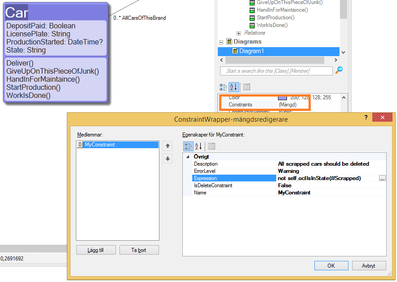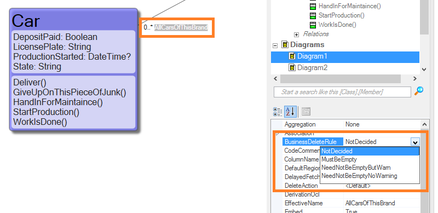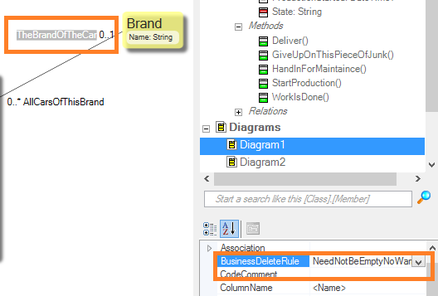(Created page with "There are other ways to introduce business rules in the model than using state machines and guards. You can also use constraints. The model already has a lot of implicit const...") |
No edit summary |
||
| Line 1: | Line 1: | ||
There are other ways to introduce business rules in the model than using state machines and guards. You can | There are other ways to introduce business rules in the model than using state machines and guards. You can use '''constraints'''. | ||
The model already has a lot of implicit constraints from the cardinalities of the association ends. Like if you have cardinality 1..4 and you have zero objects in that relation – then you have broken constraint. | |||
===== Define constraints ===== | |||
But you may also define you own constraints: | But you may also define you own constraints: | ||
| Line 7: | Line 10: | ||
You can choose if a broken constraint (a constraint that evaluates to false) should be treated as Information, Warning or a Error to the user. | You can choose if a broken constraint (a constraint that evaluates to false) should be treated as Information, Warning or a Error to the user. | ||
===== Delete constraints ===== | |||
You can also define the constraint as being a delete constraint only: | You can also define the constraint as being a delete constraint only: | ||
| Line 26: | Line 30: | ||
I set that to “NeedNotBeEmptyNoWarning” – because deleting a car-object is ok even if it has a brand. | I set that to “NeedNotBeEmptyNoWarning” – because deleting a car-object is ok even if it has a brand. | ||
===== Constraints evaluation in OCL ===== | |||
If you want to evaluate constraints in OCL, use [[OCLOperators constraints]] for example. | |||
[[Category:UML]] | [[Category:UML]] | ||
Revision as of 15:25, 14 December 2018
There are other ways to introduce business rules in the model than using state machines and guards. You can use constraints.
The model already has a lot of implicit constraints from the cardinalities of the association ends. Like if you have cardinality 1..4 and you have zero objects in that relation – then you have broken constraint.
Define constraints
But you may also define you own constraints:
You can choose if a broken constraint (a constraint that evaluates to false) should be treated as Information, Warning or a Error to the user.
Delete constraints
You can also define the constraint as being a delete constraint only:
This way have explained at the model level that the domain does not consider it to be ok to delete a Car-object as long as we have the deposit – unless it is in state Scrapped.
The delete constraints will be checked when is Deleted by MDriven – as a result of the Delete operator is executed on the class.
Other things that are checked when the Delete operator is run are the BusinessDeleteRules that exists on all association endpoints:
We as modelers should decide what the best rule is for each association end. In this case – is it ok to delete a Brand if there are Cars left in the AllCarsOfThisBrand association? No I think not. I am setting it to “MustBeEmpty”.
The association in the other direct on the other hand
I set that to “NeedNotBeEmptyNoWarning” – because deleting a car-object is ok even if it has a brand.
Constraints evaluation in OCL
If you want to evaluate constraints in OCL, use OCLOperators constraints for example.




